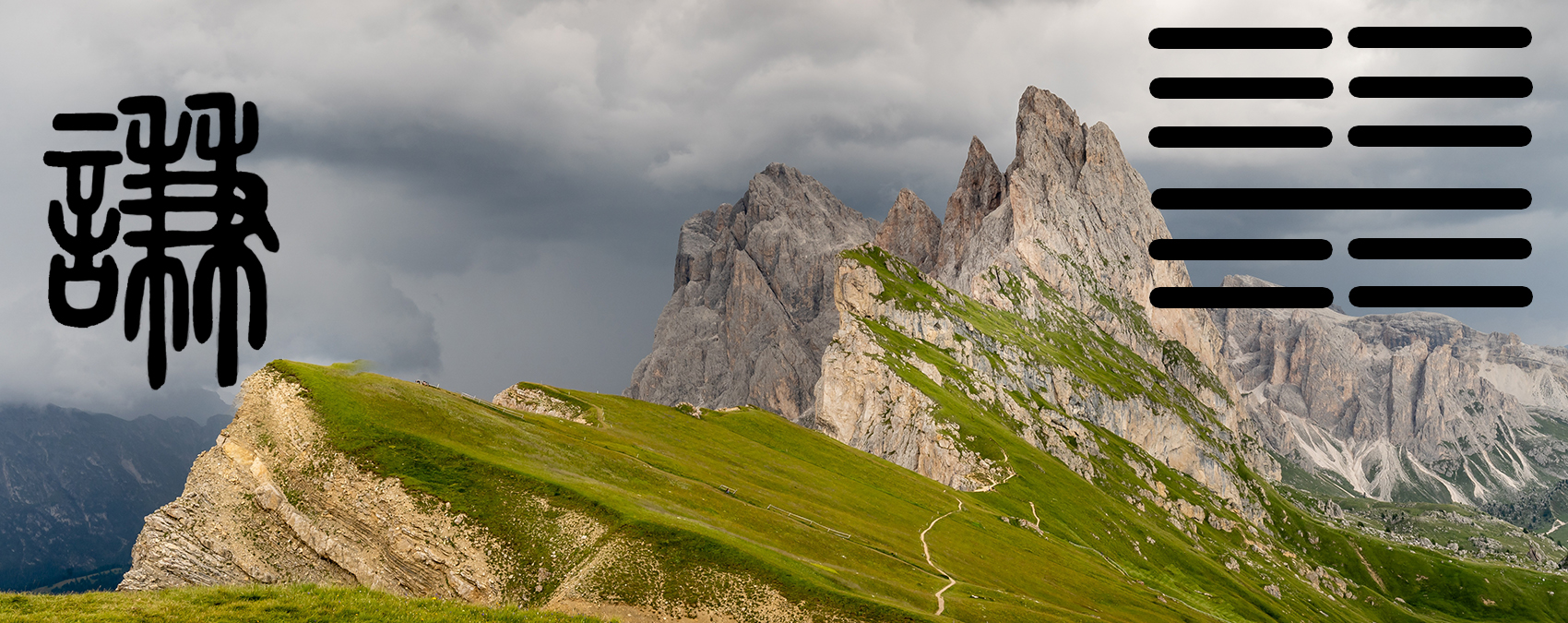Earth above – Mountain below
Qiān is the Chinese name for this hexagram. It is differentiated from Qián in Hexagram 1 because they are two distinct Chinese characters. The essence of this version of Qiān is revealed, at least in part, by the names such as Humbleness, Authenticity, Modesty, Humility, Balance, Respect. The unusual positioning of Mountain below Earth beautifully symbolizes modesty or humility because that which is firm and unyielding places itself below that which is receptive and gentle.
Breaking down the symbolism of the 3-line trigrams helps with understanding the ancient teachings:

When trigram Mountain is below (as in the image below right), it references the inner realm of the person or situation. Trigram Mountain represents the reality you stand upon as an individual in its stillness, dependability, history and power of presence. Mountain’s sheer solidity also stands as a barrier to ward things off. As the inner impetus, one’s individuality and values are moving up and out into the reality of the world.
Trigram Earth is on top of trigram Mountain. Earth is the externalizing element of this hexagram, shaping the real-world expression through her attributes. Earth accepts, nurtures and assists growth but she also removes those things which need to be removed because, just as importantly, she can be impersonally harsh as needed to keep healthy balance.
The ancient ideograph is on the left portion of the image below. On the left side the image is of a man’s face with an open mouth speaking with humility. The right figure shows two wheat bundles with a hand with 3 fingers in the middle, suggesting something being equally divided. When understood together, the person of integrity or one who has humility weighs things and takes action to ensure they are equally and fairly balanced.

In summary: The hexagram image of Mountain hidden below Earth shows the quiet, impregnable power of will (mountain) influencing everything and yet being hidden from view within an outer demeanor of receptivity (earth). If a creature in nature dominates others, the resulting imbalance destroys habitat for all. The same situation occurs when one person or group tries to use too much power over others or one personality trait unbalances a personality. Learning to live an authentic life, while taking others into consideration, means walking a path of modesty and integrity.
Following are a few ideas for interpretations of each line:
Line 1 – The outer situation at this time of beginning is not as important as the quality of humility with which it is approached. There are indications of a difficult task ahead, but assurances of success accompany this line position provided one can maintain a modest and disciplined attitude (so as to not invite challenge or create resistance).
Line 2 – One at this position has the ability to attract congenial and empathetic resonance from the environment. Modesty and attending to what is real is what attracts the rewards and supportive people. The council is to keep on with the work, there is much of it ahead.
Line 3 – This placement suggests continuing with the work, it is important to remain true to yourself. This may be the integral part of this challenge: maintaining the resolve that originally led you to the task.
Line 4 – A promising placement as long as one is able to resist the temptation to exceed their individual authority. True modesty is a recognition of reality and is not trying to be above or below their own station.
Line 5 – At this position one may need to use force to make corrections, but it can be done firmly and quietly. Humility does not preclude utilizing disciplinary or defensive action when called for.
Line 6 – Perhaps one’s aims have not been totally achieved. The ancients point, not to doubling down on outward efforts or assigning blame, but in honest recognition of what natural limitations may exist within the reality of the goals. Even more than that, they suggest examining and discipling your own inner responses such as emotions, temptations, drives, etc.
